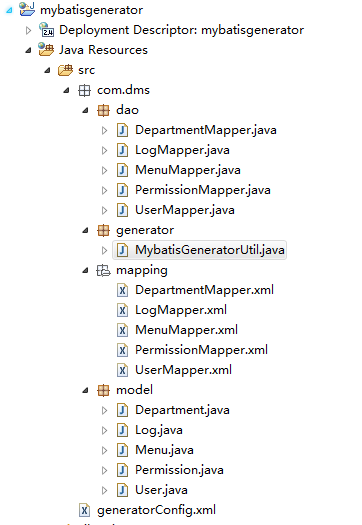功能:
mybatis-generator 是mybatis提供的根据数据库生成,实体类、mapper、还有dao层的。
使用说明
步骤一:下载jar包
1:mybatis-generator
2:数据库驱动包(这里选择的是MySQL)mysql-connector-java-5.1.5-bin.jar
说明:mybatis-generator 放在项目下,mysql-connector-java-5.1.5-bin.jar随便放个位置在generatorConfig.xml指向他就行。
所用的包在后面附件里有。ps:附件是整个测试项目。
步骤二:编写generator 配置的xml 取名为:generatorConfig.xml (这个名字可以随便取和后面对应就行)
其中包括数据库的信息、生成文件的路径等等 内容举例如下:
<?xml version="1.0" encoding="UTF-8"?>
<!DOCTYPE generatorConfiguration
PUBLIC "-//mybatis.org//DTD MyBatis Generator Configuration 1.0//EN"
"http://mybatis.org/dtd/mybatis-generator-config_1_0.dtd">
<generatorConfiguration>
<!-- 数据库驱动-->
<classPathEntry location="d:\mysql-connector-java-5.1.5-bin.jar"/>
<context id="DB2Tables" targetRuntime="MyBatis3">
<commentGenerator>
<property name="suppressDate" value="true"/>
<!-- 是否去除自动生成的注释 true:是 : false:否 -->
<property name="suppressAllComments" value="false"/>
</commentGenerator>
<!--数据库链接URL,用户名、密码 -->
<jdbcConnection driverClass="com.mysql.jdbc.Driver" connectionURL="jdbc:mysql://localhost/xujw" userId="root" password="123456">
</jdbcConnection>
<javaTypeResolver>
<property name="forceBigDecimals" value="false"/>
</javaTypeResolver>
<!-- 生成模型的包名和位置-->
<javaModelGenerator targetPackage="com.dms.model" targetProject="src">
<property name="enableSubPackages" value="true"/>
<property name="trimStrings" value="false"/>
</javaModelGenerator>
<!-- 生成映射文件的包名和位置-->
<sqlMapGenerator targetPackage="com.dms.mapping" targetProject="src">
<property name="enableSubPackages" value="true"/>
</sqlMapGenerator>
<!-- 生成DAO的包名和位置-->
<javaClientGenerator type="XMLMAPPER" targetPackage="com.dms.dao" targetProject="src">
<property name="enableSubPackages" value="true"/>
</javaClientGenerator>
<!-- 要生成哪些表-->
<table tableName="dms_department" domainObjectName="Department" enableCountByExample="false" enableUpdateByExample="false" enableDeleteByExample="false" enableSelectByExample="false" selectByExampleQueryId="false"></table>
<table tableName="dms_log" domainObjectName="Log" enableCountByExample="false" enableUpdateByExample="false" enableDeleteByExample="false" enableSelectByExample="false" selectByExampleQueryId="false"></table>
<table tableName="dms_menu" domainObjectName="Menu" enableCountByExample="false" enableUpdateByExample="false" enableDeleteByExample="false" enableSelectByExample="false" selectByExampleQueryId="false"></table>
<table tableName="dms_permission" domainObjectName="Permission" enableCountByExample="false" enableUpdateByExample="false" enableDeleteByExample="false" enableSelectByExample="false" selectByExampleQueryId="false"></table>
<table tableName="dms_user" domainObjectName="User" enableCountByExample="false" enableUpdateByExample="false" enableDeleteByExample="false" enableSelectByExample="false" selectByExampleQueryId="false"></table>
</context>
</generatorConfiguration>
有多种方法,这里取的是用Java类生成 代码如下:
package com.dms.generator;
import java.io.File;
import java.util.ArrayList;
import java.util.List;
import org.mybatis.generator.api.MyBatisGenerator;
import org.mybatis.generator.config.Configuration;
import org.mybatis.generator.config.xml.ConfigurationParser;
import org.mybatis.generator.internal.DefaultShellCallback;
public class MybatisGeneratorUtil {
public static void main(String[] args) {
try {
List<String> warnings = new ArrayList<String>();
boolean overwrite = true;
File configFile = new File(MybatisGeneratorUtil.class.getResource("/generatorConfig.xml").getFile());
ConfigurationParser cp = new ConfigurationParser(warnings);
Configuration config = cp.parseConfiguration(configFile);
DefaultShellCallback callback = new DefaultShellCallback(overwrite);
MyBatisGenerator myBatisGenerator = new MyBatisGenerator(config, callback, warnings);
myBatisGenerator.generate(null);
System.out.println("生成完毕,请刷新项目!");
} catch (Exception e) {
e.printStackTrace();
}
}
}
附件:项目代码举例
























 235
235

 被折叠的 条评论
为什么被折叠?
被折叠的 条评论
为什么被折叠?








